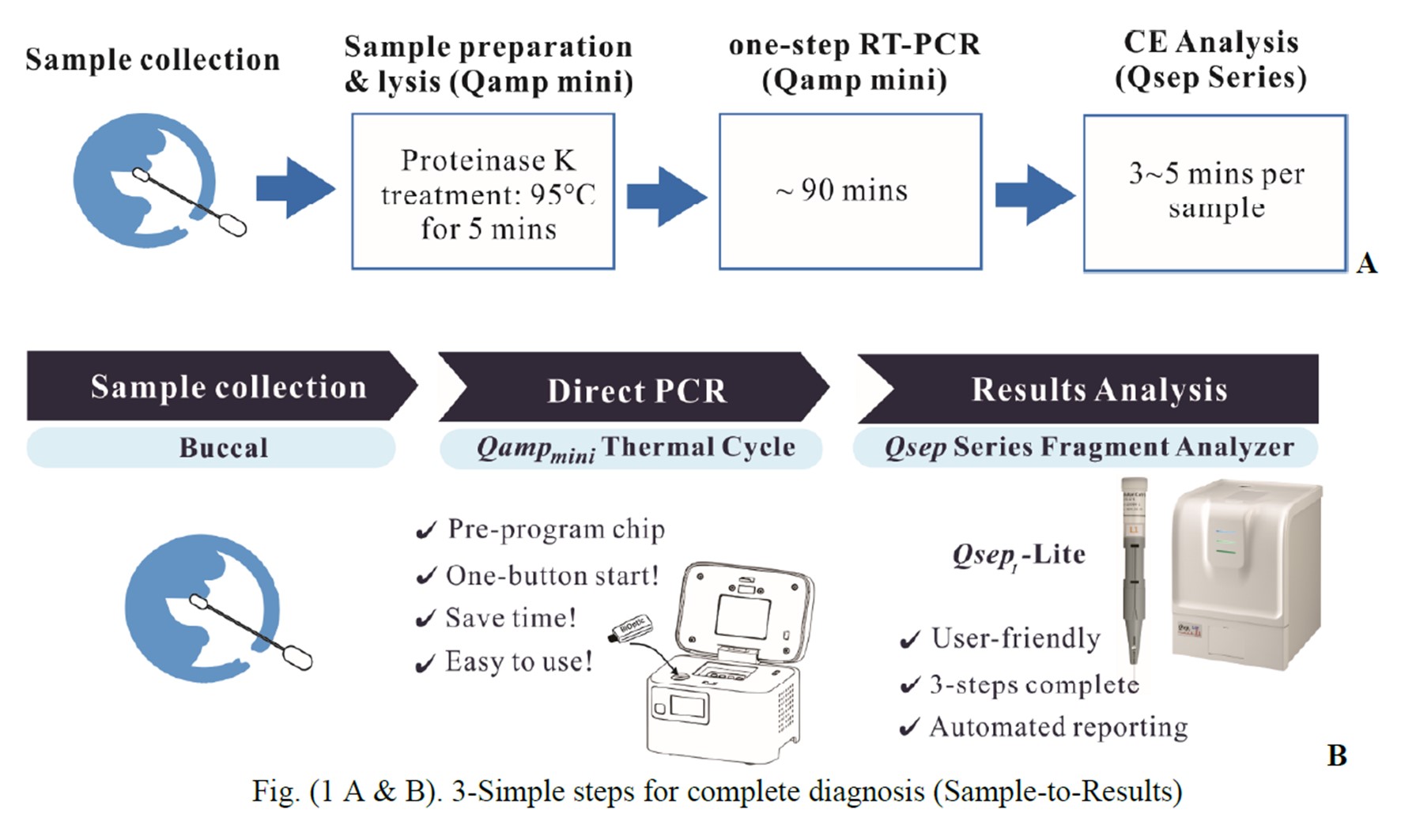Publications
Menu+

Direct SARS-CoV-2 Detection System Utilizing Simple-to-Use Capillary Gel Electrophoresis
2022-11-09We present a Direct SARS-CoV-2 Detection System that achieves sample-to-results in less than two hours in three simple steps. The Detection System includes Direct one-step Reverse Transcription PCR (RT-PCR) reagents (Qexp-MDx kit), a portable thermal cycler (Qamp-mini) with a pre-programmed chip, and a simple-to-use Capillary Gel Electrophoresis system (Qsep Series Bio-Fragment Analyzer) with high fluorescence detection sensitivity to solve the problems associated with traditional real-time PCR (qPCR) systems which produce inaccurate test results with high false negative and false positive rates.
SARS-CoV-2 RNA Virus Detection from Saliva Samples
2021-04-29A simple methodology for detecting viral SARS-CoV-2 RNA from saliva samples using direct reverse-transcription polymerase chain reaction (RT-PCR) and capillary gel electrophoresis with fluorescence detection is presented. The simplified process minimizes the sample collection and treatment steps by eliminating the need for RNA extraction and purification.
Combination of multiplex reverse transcription recombinase polymerase amplification assay
2020-03-21The pandemic of avian influenza viruses (AIVs) in Asia has caused enormous economic loss in poultry industry and human health threat, especially clade 2.3.4.4 H5 and H7 subtypes in recent years. The endemic chicken H6 virus in Taiwan has also brought about human and dog infections. Since wild waterfowls is the major AIV reservoir, it is important to monitor the diversified subtypes in wildfowl flocks in early stage to prevent viral reassortment and transmission. To develop a more efficient and sensitive approach is a key issue in epidemic control.
Ultrafast haplotyping of putative microRNA-binding sites in the WFS1 gene by multiplex PCR
2013-04-19The transmembrane protein wolframin (WSF1) plays a crucial role in cell integrity in pancreatic beta cells and maintaining ER homeostasis. Genetic variations in the WFS1 gene have been described to be associated with Wolfram syndrome or type 2 diabetes mellitus. In this paper we report on an efficient double-tube allele-specific amplification method in conjunction with ultrafast capillary gel electrophoresis for direct haplotyping analysis of the SNPs in two important miRNA-binding sites (rs1046322 and rs9457) in the WFS1 gene.
A Multichannel Capillary Electrophoresis System for the Analysis of Fluorescently Labeled Proteins
2018-08-24Electrophoresis is an analytical method frequently used in nucleic acid and protein analysis to separate macromolecules such as DNA, RNA, and proteins based on their size and charge. The technique is widely employed in the fields of medical diagnostics, life sciences, and clinical research.
Capillary electrophoresis (CE) systems separate nucleic acids and proteins with high accuracy and in a short period of time. CE separates molecules according to charge and size. The basic difference between capillary electrophoresis and gel electrophoresis is that, in CE, molecules are separated inside a small capillary tube filled with conductive buffer rather than gel. Separation of molecules using CE is faster and provides higher resolution because the thin tubes have a higher surface-to-volume ratio, which enables heat to dissipate faster and the system to run at high voltages without overheating. Moreover, CE requires only a small amount of sample, conserving rare and expensive samples.
Rapid Genetic Identification of Meat
2020-04-25As the demand for food research and monitoring continues to increase, simple and fast solutions are needed. This article describes a workflow that rapidly determines the identity of meat in the field using the Qampmini Thermal cycler for PCR-mediated DNA amplification and the Qsep1 Bio-Fragment Analyzer (both from BiOptic, Inc., New Taipei City, Taiwan) for the analysis of PCR product by capillary gel electrophoresis.
Light‐emitting diode induced fluorescence (LED‐IF) detection design for a pen‐shaped
2012-06-21CGE is a well-established separation technique for the analysis of biologically important molecules such as nucleic acids. The inherent high resolving power, rapid analysis times, excellent detection sensitivity, and quantification capabilities makes this method favorable compared to conventional manual polyacrylamide and agarose slab gel electrophoresis techniques. In this paper we introduce a novel single-channel capillary gel electrophoresis system with LED-induced fluorescence detection also utilizing a compact pen-shaped capillary cartridge design for automatic analysis of samples from a 96-well plate. To evaluate the suitability of the system, 1000 genomic DNA(gDNA) samples were analyzed in gel filled capillaries and detected by the microball ended excitation and emission optical fiber based LED-induced fluorescence detection system. Excellent migration time reproducibility of RSD <0.75% was obtained over the course of 1000 runs. The system rapidly distinguished between intact and degraded gDNA samples, therefore provided important information if they could be used for downstream quantitative PCR processing where high-quality intact gDNA was key. We envision that this novel system design will rapidly find new applications in both research and clinical diagnostic laboratories as a highly sensitive and easy to use bio-analytical approach.
A Portable CGE System for Cell Free DNA Detection
2018-01-29Cell free DNA (cfDNA) is present in human blood at varying levels, generally from 1 to 50 ng per mL of plasma. It is typically 100–500 bp in length (with most fragments about 160–180 bp long), making traditional DNA extraction difficult. The key to successful analysis of cfDNA is to ensure efficient purification of smaller DNA fragments (100–500 bp). For this study, the researchers used the cfPure cell free DNA extraction kit from BioChain (Newark, CA), which efficiently recovers these important small fragments. The kit employs a magnetic bead-based DNA extraction method for the recovered cell free DNA. For sensitive applications such as next-generation sequencing, kit performance is comparable to currently available spin column-based cfDNA kits. The recovered DNA is suitable for a wide range of downstream applications, such as bisulfite sequencing, NGS, and qPCR.
